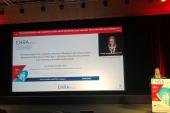DOACs Safe, Effective in Subset of Valvular AF Patients
A large, retrospective study addressed patients with disease in any of the four valves, but not those with prosthetic implants.

Helping to fill an evidence gap, a retrospective review of a large database of US commercial health claims indicates that in patients with valvular atrial fibrillation (AF), direct oral anticoagulants (DOACs) are associated with lower risks of stroke, systemic embolism, and major bleeding compared with warfarin.
The findings shed light on a topic that has proved confusing for clinicians due to the different definitions of “valvular heart disease” used across clinical trials and guidelines. Patients with both AF and valve disease were excluded from the randomized trials that led to the approval of apixaban (Eliquis; Bristol-Myers Squibb), edoxaban (Savaysa; Daiichi-Sankyo), rivaroxaban (Xarelto; Bayer/Janssen), and dabigatran (Pradaxa; Boehringer Ingelheim) in the United States, so their safety and efficacy in this setting remains unclear.
Lead author on the study, Ghadeer Dawwas, PhD (University of Pennsylvania, Philadelphia), pointed out that concomitant AF and valve disease, defined as any diagnosis of aortic, mitral, tricuspid, or pulmonary valve disease, is relatively common, yet the management of these patients has been inconsistent due to the lack of data on the newer anticoagulants in this setting as well as the differing definitions of valvular AF.
“Our main finding,” she told TCTMD, in patients with this broader definition of valvular atrial fibrillation, “is that DOACs [compared to warfarin] were effective for the prevention of stroke or systemic inflammation and were associated with a lower rate of major bleeding events, which as we know is a major concern in patients taking DOACs.”
Current guidelines recommend warfarin in patients with valvular heart disease, but here that’s defined as patients with moderate-to-severe mitral stenosis (potentially requiring surgical intervention) or who have a mechanical heart valve.
The paper was published this week in Annals of Internal Medicine.
Claims Database Analysis
Dawwas et al reviewed patients started on a DOAC between January 2010 and June 2019 in OptumInsight Clinformatics, an administrative database capturing information from privately insured US patients. In all, more than 56,000 patients had a diagnosis of AF and valvular heart disease based on ICD-9-CM and ICD-10-CM codes. At a median follow-up of 134 days, those prescribed a DOAC had lower incidences of ischemic stroke or systemic embolism (HR 0.64; 95% CI 0.59-0.70) and major bleeding (HR 0.67; 95% CI 0.63-0.72).
In an interesting secondary finding, efficacy and safety both appeared consistent for apixaban and rivaroxaban, whereas the dabigatran results were similar for the reduced bleeding outcome but were not consistent with the other two DOACs for efficacy; lower numbers, though, make this analysis less reliable, Dawwas said. Patient numbers for edoxaban (70) were too few to be included in the analyses.
Commenting on the study for TCTMD, Craig January, MD, PhD (University of Wisconsin, Madison), who led the 2019 American College of Cardiology/American Heart Association atrial fibrillation guideline update, zeroed in on the different findings by DOAC. Apixaban, he noted, has also showed signs in other studies as having the best efficacy without an increased risk of bleeding, a finding apparently borne out here.
January was cautious, however, in drawing too much from the primary study results, given that the numbers are based on administrative claims.
In his opinion, the findings are largely confirmatory of what the current guidelines recommend and nothing in this paper would warrant any changes. “This was a large patient cohort, and it supports the idea that DOACs work and that they may be more effective with less bleeding than warfarin,” said January. “There’s nothing earthshaking here, but I also don’t want [people] to walk away with the idea that I don't think this a piece of useful information. I do think it is.”
While it’s true that the major DOAC trials, by design, excluded valvular heart disease, January pointed out that even with that strict enrollment criteria in place, roughly 20% of patients enrolled in the pivotal trials had some form of valve disease. As such, the wide definition used for billing codes in this Annals paper likely reflects the kind of subpopulation included in the DOAC trials.
The recommendation in the mechanical-valve group is supported by the results of RE-ALIGN, stopped early after increased rates of thromboembolic and bleeding events among patients on dabigatran, January noted. But in patients with bioprosthetic valves, he continued, the issue of which anticoagulant is best “is an important one that’s not resolved,” and those patients are not included in the valvular heart disease patients studied here, January stressed. “This was designed to study native diseased heart valves [based on] billing codes that included aortic, mitral, tricuspid, and pulmonic heart valves,” he said, “so it does provide some information in this subset of patients that says that DOACs are better than warfarin and so that part of it is new and useful.”
Most important, the Dawwas paper does not provide any information on valve-disease severity, he noted. “So we really don’t know whether this was an incidental murmur, a little bit of calcium in a heart valve, or whether some of these patients could have had severe valve disease, so that’s a limitation of the study.”
To TCTMD, Dawwas stressed that the aim of the study was to understand how the newer anticoagulants were performing in patients with valvular disease and dysfunction, given that their use has risen steadily over the study period. “Based on the results of our study, we believe that DOACs can be effective and safe alternatives to warfarin in patients with atrial fibrillation and this might provide treatment options, especially in patients who receive suboptimal benefits from warfarin therapy,” she said.
Shelley Wood was the Editor-in-Chief of TCTMD and the Editorial Director at the Cardiovascular Research Foundation (CRF) from October 2015…
Read Full BioSources
Dawwas GK, Dietrich E, Cuker A, et al. Effectiveness and safety of direct oral anticoagulants versus warfarin in patients with valvular atrial fibrillation a population-based cohort study. Ann Intern Med. 2021;Epub ahead of print.
Disclosures
- Dawwas reports no relevant conflicts of interest.
- January reports serving as a consultant for the ACC, CredibleMeds, and Gilead





Comments